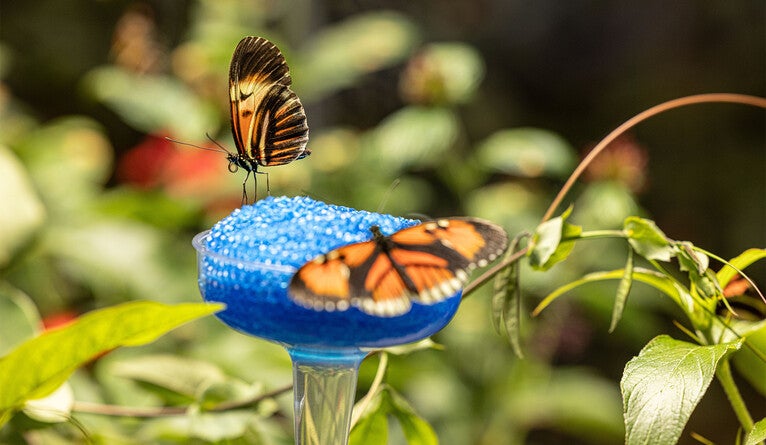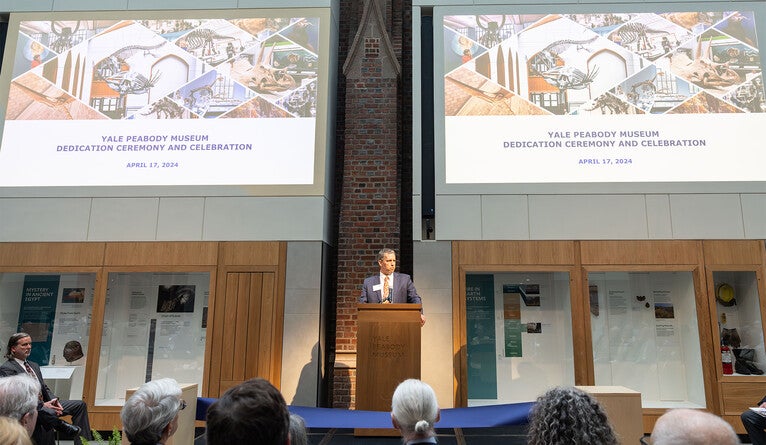World
At renovated Peabody Museum, Yale reopens its ‘front door’ to the world

During the dedication ceremony for the newly renovated Yale Peabody Museum this week, President Peter Salovey mused over which part of campus serves as Yale’s front door to the world.
Is it the College Street corridor, the new home of the Wu Tsai Institute located in the heart of New Haven? Or the stretch of Trumbull Street that greets motorists entering the city off I-91?
Perhaps, he said, it’s actually a specific room within the Peabody Museum itself that has been beloved by generations of Connecticut schoolchildren.
“If this is the most-visited spot in Connecticut by a child, then I would argue that the [Burke Dinosaur Hall] here at the Peabody is our front door,” Salovey said, speaking on April 17 before an audience of invited guests under the skylights of the museum’s new Central Gallery.
The ribbon-cutting event officially closed a four-year period of renovation and renewal that has transformed the museum into a dynamic center of participatory learning, groundbreaking research, and more accessible exhibitions that present the ever-changing story of life on Earth to a new generation of schoolchildren, university students, and guests from New Haven, the region, and the world.
In his remarks, Salovey repeated the dedication given during the building’s official opening in December 1925:
“Here, for generations to come, serious students will assemble for the intensive study of those profound and revealing chapters in nature’s history, which are here written,” he said, quoting the original pronouncement. “[Here] will come citizens young and old to gain broader and deeper conceptions of the history of life, of the Earth, and its structure and its place in the cosmos.
“Most important perhaps of all, here will go constantly forward the search for new truth, whose discovery is the abundant reward of those who seek by unflagging study to unlock the hidden secrets of nature.”
The museum’s comprehensive renovation, he said, facilitates these ambitions, which were expressed nearly a century ago.
“I take it that the Peabody’s hallmarks have been restored,” Salovey said. “The ways in which it is going to welcome students; the opportunity for visiting scholars to work here and collaborate; the opportunity for Yale faculty to join learners of all ages in the process of discovery.”
The renovation was made possible by a landmark $160 million gift from philanthropist Edward P. Bass ’67, who attended the dedication, along with generous contributions from Coleman P. Burke ’63, Thomas Jaffee ’71, and other donors. Designed by Connecticut-based Centerbrook Architects and Planners, the project expanded the museum’s galleries by more than 50%, added 12 classrooms scattered throughout the building, new research labs, and a new education center for K-12 students from the New Haven area.
The Peabody also now offers free public admission, making it more accessible than ever before.
“There are so many ways in which the Peabody Museum reflects our core mission,” Salovey said. “It’s all about education. It’s all about research. It’s all about preservation. It’s all about innovation.”
The museum reopened to the public on March 26. Fittingly, its first guests were busloads of students from New Haven public schools. At the time, the third floor remained closed, but many of its exhibits and galleries are now open, including the museum’s treasured dioramas of taxidermy specimens, a new “Dynamic Future” gallery focused on how evolution drives Earth’s rich biodiversity, and “The Living Lab,” populated by live plants and animals, including a glass terrarium housing about 30 red, white, and black Postman butterflies. David Friend Hall, a state-of-art gem and mineral gallery, and a new Hall of the Pacific, will open in the coming weeks.

Salovey thanked Bass and other donors for their generosity and praised Peabody Director David Skelly for deftly leading the massive and complex project.
In his remarks welcoming the guests, Skelly, who was recently appointed to a third five-year term as the museum’s director, thanked Salovey and the university’s administration as well as the donors and former Yale provost and past Peabody Director Alison Richard, who chairs the Peabody Leadership Council, for their support and guidance.
He recalled how the 2016 opening of David Friend Hall demonstrated the potential to reimagine and revitalize the entire museum for the 21st century. (David Friend ’69 also supported the building renovation.)
“Completing that project… was a little like painting one wall of your house,” Skelly said, noting that the rest of the museum needed updating.

Skelly described an early conversation with Bass, in which they discussed reimagining the entire museum.
“We weren’t going to just paint a wall of the house, we were going to rebuild the house,” Skelly said.
He closed with a heartfelt thanks to the museum’s staff members, whose work in preparing the museum for renovation, caring for its collections and facilitating research during construction, and creating its revitalized exhibits was indispensable to the project’s success.
“They saw the opportunity, understood what it was,” he said. “They had the patience and had the vision to get us where we are now.”










